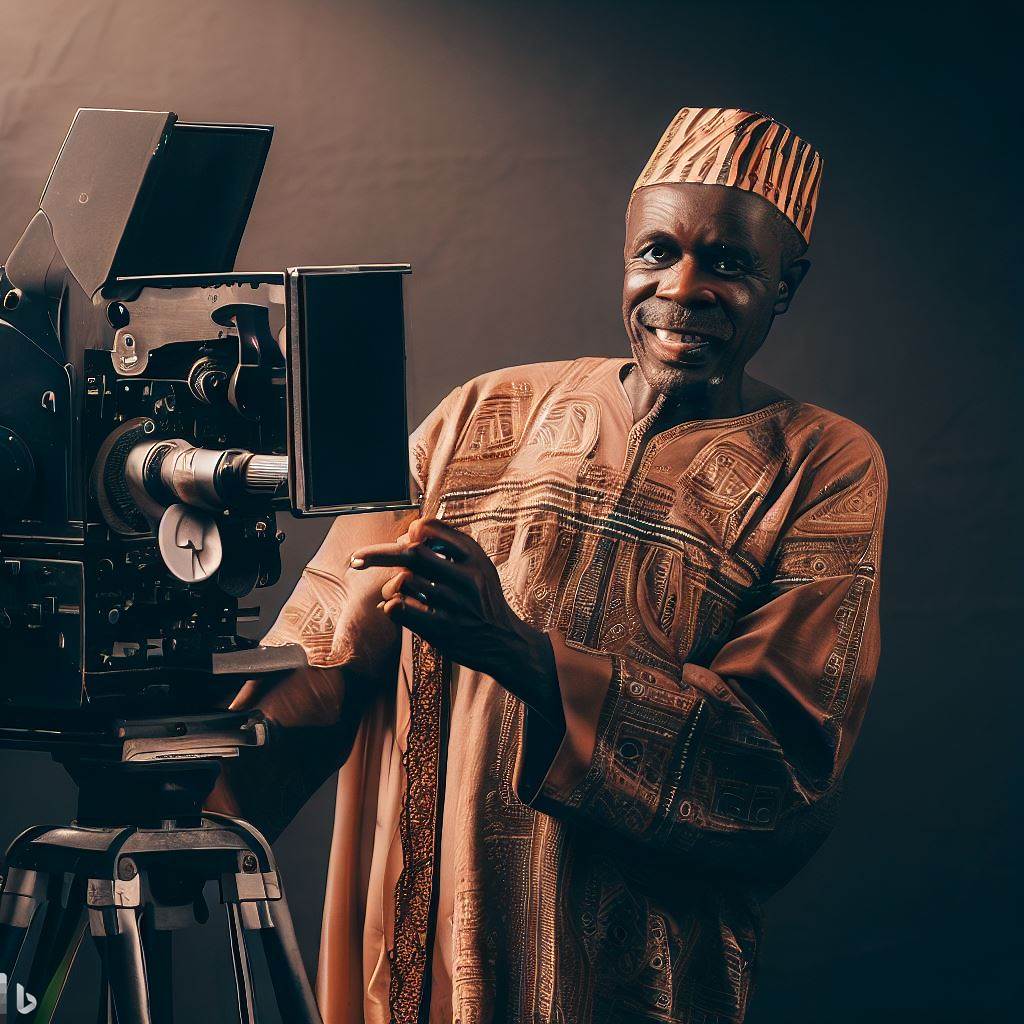Introduction
A. The concept of cinematography
Cinematography is the art of capturing moving images on film or digitally.
B. Overview of Nigerian cinema and its growth over the years
Nigerian cinema has seen significant growth and development over the years.
Nigerian cinema, also known as Nollywood, has come a long way since its inception.
Cinematography, which is the art of capturing moving images on film or digitally, plays a crucial role in the evolution and success of Nigerian cinema.
Nollywood, the third-largest film industry in the world, has grown exponentially over the years.
From its humble beginnings in the early 1990s, Nigerian cinema has experienced remarkable growth in terms of production quality, storytelling, and global recognition.
At the start, Nigerian films were of low quality, featuring poor lighting, sound, and cinematography.
However, as the industry matured, filmmakers began to pay more attention to these technical aspects, resulting in significant improvements in visual aesthetics.
The advancements in technology have also played a vital role in shaping contemporary Nigerian cinema.
With the introduction of digital cameras and editing software, filmmakers now have more creative freedom and can experiment with various visual techniques.
Moreover, Nigerian cinema has gained international acclaim for its unique storytelling techniques and cultural representation.
Many Nollywood films explore social issues, cultural traditions, and identity, presenting a rich tapestry of Nigerian society.
Nigerian cinema has come a long way in terms of cinematography, production quality, and global recognition.
As the industry continues to evolve, it will be interesting to witness the future advancements and contributions of Nigerian filmmakers to the world of cinematography.
Past Cinematography in Nigerian Cinema
A. The early years of Nigerian cinema and its limitations
- The Nigerian film industry emerged in the late 19th century with the production of the first Nigerian film, “Palaver,” in 1926.
- During this period, Nigerian filmmakers faced numerous challenges, including limited funding and access to equipment.
- Most early Nigerian films were produced by foreign companies, resulting in limited creative control and representation of Nigerian culture.
- The cinematography during this time was basic, with black and white visuals and minimal technical innovations.
- Nigerian filmmakers relied heavily on storytelling and narrative to compensate for the technological shortcomings.
B. The evolution of cinematography techniques during the 20th century
- In the 1960s, Nigerian cinema experienced a significant shift with the introduction of color films.
- This advancement allowed for more vibrant visuals and enhanced storytelling.
- During the 1970s, Nigerian filmmakers started experimenting with new techniques, such as camera movements and composition.
- Improved film stocks and lighting equipment further contributed to the growth of Nigerian cinematography during this period.
- The 1980s witnessed the use of different aspect ratios and the exploration of various visual styles.
C. The major contributors to Nigerian cinematography in the past
- Hubert Ogunde, often referred to as the “father of Nigerian cinema,” played a crucial role in pioneering Nigerian filmmaking in the 1950s.
- Later, Ola Balogun emerged as a prominent figure in Nigerian cinema, introducing more technical innovations and experimenting with storytelling techniques.
- Lancelot Oduwa Imasuen and Tunde Kelani brought significant contributions to Nigerian cinematography in the 1990s and 2000s.
- These filmmakers focused on improving the technical aspects of cinematography, including camera movements and lighting.
- Overall, the past of Nigerian cinematography laid a foundation for the growth and development of the industry, setting the stage for future advancements.
The Nigerian film industry continues to evolve and grow, with new talents emerging and making their mark on the global stage.
Read:Emerging Trends in the Make-up Artist Profession in Nigeria
Significance of Cinematography in Nigerian Cinema
A. The role of cinematography in storytelling and creating visual aesthetics
- Cinematography plays a crucial role in enhancing the storytelling process in Nigerian cinema.
- Through the use of camera angles, lighting, composition, and movement, cinematography brings narratives to life.
- The visual elements captured by cinematographers help to convey the mood, atmosphere, and emotions within a film.
- By selecting the right shots and framing techniques, cinematography enhances character development and plot progression.
- The visual aesthetics crafted through cinematography contribute to the overall cinematic experience.
B. Impact of improved cinematography on the quality of Nigerian films
- Improvements in cinematography have led to a significant rise in the quality of Nigerian films.
- Better technical capabilities and equipment have allowed filmmakers to capture stunning visuals and create immersive experiences.
- The advancement in cinematography techniques has elevated the production value of Nigerian films.
- Enhanced visuals attract a wider audience and increase the international recognition of Nigerian cinema.
- The use of innovative cinematography has positioned Nigerian films among top-notch productions globally.
C. How cinematography influences audience engagement and emotional response
- Cinematography plays a vital role in capturing the audience’s attention and immersing them within the film’s world.
- The visual aspects shape the audience’s perception of characters, events, and themes.
- Well-executed cinematography can generate a sense of intrigue, suspense, or excitement, evoking emotional responses.
- Through cinematography, filmmakers can effectively communicate the intended messages and themes to the audience.
- The ability to connect with viewers on an emotional level amplifies the impact and influence of Nigerian films.
Cinematography stands as a cornerstone of Nigerian cinema, leveraging its power to portray compelling stories, create visually appealing aesthetics, and enhance audience engagement.
The role of cinematography in storytelling cannot be underestimated.
It goes beyond the technical aspects of capturing images; it encapsulates the art of visually narrating a film’s plot, enhancing character development, and conveying the intended emotions.
With advancements in cinematography techniques, Nigerian filmmakers have been able to raise the quality of their films.
Improved technical capabilities, paired with creative vision, result in breathtaking visuals and immersive experiences.
This transformation is especially crucial for Nigerian cinema’s growth, as it elevates the production value and attracts a wider audience, both domestically and internationally.
Moreover, the impact of cinematography on audience engagement and emotional response is profound.
Cinematographers use camera angles, lighting, and composition to steer audience perception and evoke emotional ties to on-screen characters.
Effective cinematography triggers an array of emotions, generating intrigue, suspense, or excitement, further reinforcing the impact of Nigerian films.
The significance of cinematography in Nigerian cinema goes beyond technical expertise.
It serves as a catalyst for conveying powerful messages, captivating viewers, and elevating the medium’s artistic value.
Read:Women in PR: Breaking Barriers in Nigeria
Present Cinematography in Nigerian Cinema
A. Advancements in technology that have improved cinematography in recent years
- Introduction of high-quality cameras and equipment has revolutionized cinematography in Nigerian cinema.
- Advanced digital cameras offer better resolution, color accuracy, and low-light capabilities.
- The use of drones has allowed for aerial shots, giving films a more cinematic and immersive feel.
- Steadicam technology has made it easier for cinematographers to achieve stable and smooth shots.
- Improved lighting equipment and techniques have enhanced the visual appeal of Nigerian films.
B. The growing number of skilled cinematographers in the Nigerian film industry
- Nigerian cinema is experiencing a surge in the number of talented cinematographers.
- These professionals possess both technical expertise and a deep understanding of storytelling.
- Many cinematographers have received international recognition for their work, showcasing the talent within the industry.
- The growing demand for high-quality visuals has motivated aspiring cinematographers to hone their skills.
- Training programs and workshops have been established to nurture the next generation of cinematographers in Nigeria.
C. Examples of recent Nigerian films with remarkable cinematography
- “The Milkmaid” directed by Desmond Ovbiagele showcases breathtaking landscape shots and captivating visual storytelling.
- “Living in Bondage: Breaking Free” directed by Ramsey Nouah combines vibrant colors and creative camera angles.
- “The Delivery Boy” directed by Adekunle “Nodash” Adejuyigbe features visually striking compositions and atmospheric lighting.
- “93 Days” directed by Steve Gukas beautifully captures the intensity and emotion of the story through its cinematography.
- “Up North” directed by Tope Oshin offers stunning visuals of Nigeria’s northern region, showcasing its natural beauty.
The advancements in technology have transformed the landscape of cinematography in Nigerian cinema.
With the availability of high-quality cameras, equipment, and innovative techniques, Nigerian films now boast remarkable cinematography.
Additionally, the growing number of skilled cinematographers indicates the industry’s commitment to visual excellence.
The recognition received by Nigerian cinematographers both locally and internationally further solidifies their contribution to the growth of Nigerian cinema.
As the industry continues to evolve, it is evident that cinematography will remain a crucial element in the success of Nigerian films corporation.
Read:A Comparative Study: PR in Nigeria vs. Globally

See Related Content: In-Depth Analysis: The Nigerian Music Producer’s Workspace
Challenges and Limitations in Nigerian Cinematography
A. Address the financial constraints faced by filmmakers in investing in quality equipment.
- Filmmakers in Nigeria often struggle to invest in quality equipment due to financial constraints.
- The cost of high-end cameras, lenses, and other necessary equipment is prohibitively expensive.
- This directly impacts the quality of cinematography in Nigerian films, hindering their overall visual appeal.
- Limited funds also restrict filmmakers from experimenting with new technologies and techniques.
- Without proper equipment, filmmakers are unable to achieve the desired cinematic effects, limiting creativity.
- Funding for the acquisition and maintenance of quality equipment remains a significant challenge for Nigerian filmmakers.
- Collaboration with international production companies can alleviate some financial constraints but is not always possible.
B. The lack of formal education and training opportunities for aspiring cinematographers.
- Nigeria lacks formal education and training opportunities specific to cinematography.
- Aspiring cinematographers often struggle to receive adequate knowledge and guidance in their field.
- The absence of specialized courses and institutions limits the growth and development of cinematography in Nigeria.
- Self-learning and informal mentorships have become the primary sources of education for many cinematographers.
- Without formal training, aspiring cinematographers find it challenging to refine their skills and techniques.
- This results in a lack of consistent quality and a limited pool of skilled cinematographers in Nigeria.
- Efforts should be made to establish educational programs and institutions dedicated to cinematography.
C. The need for infrastructure development and better government support for the film industry.
- The Nigerian film industry faces infrastructure challenges that hinder the growth of cinematography.
- There is a lack of proper studios, sound stages, and post-production facilities in the country.
- These inadequacies directly affect the quality of cinematography and overall production value.
- Government support and investment in infrastructure development are crucial for the advancement of Nigerian cinematography.
- Improved facilities would attract more filmmakers and encourage the use of advanced filming techniques.
- Similarly, better government support through funding and incentives can uplift the film industry.
- The Nigerian government should recognize the economic potential of the film industry and provide necessary support.
Nigerian cinematography faces significant challenges that hinder its growth and development. Financial constraints limit filmmakers from investing in quality equipment, resulting in subpar visuals.
The lack of formal education and training for aspiring cinematographers further hampers the industry’s progress.
Additionally, inadequate infrastructure and government support restrict the potential of Nigerian cinematography.
To overcome these challenges, it is vital to address the financial limitations, establish educational programs, and develop better infrastructure with government assistance.
Only then can Nigerian cinematography flourish and compete on a global scale.
Read:Guide to PR Certifications Available in Nigeria
Future of Cinematography in Nigerian Cinema
A. Potential for Further Growth and Development
- Nigerian cinema has seen significant growth in recent years, with a promising future for cinematography.
- The local film industry, known as Nollywood, has gained international recognition, attracting more investments.
- With technological advancements, the potential for further growth in cinematography in Nigerian cinema is immense.
- The use of high-quality cameras, lighting techniques, and post-production tools can enhance the visual storytelling.
- The demand for Nigerian films is increasing globally, creating opportunities for cinematographers to showcase their skills.
- As the industry expands, there will be a need for more cinematographers, creating employment opportunities for talented individuals.
- The diverse Nigerian culture and landscapes provide unique settings for creative cinematography, attracting international audiences.
B. Collaboration with International Cinematographers and Production Companies
- Collaborations with international cinematographers can bring fresh perspectives and foster knowledge exchange.
- International production companies can provide access to advanced equipment and financing for larger-scale productions.
- Joint projects between Nigerian and international cinematographers can help create global cinematic experiences.
- Collaborations can also lead to co-productions, allowing Nigerian films to reach a wider international audience.
- Sharing experiences and techniques can help Nigerian cinematographers improve their skills and storytelling abilities.
- International collaborations can contribute to the growth and development of Nigerian cinema as a whole.
C. Importance of Continued Investment in Training and Skill Development
- Continued investment in training and skill development is crucial for aspiring Nigerian cinematographers.
- Professional training programs and workshops can help enhance technical skills and artistic vision.
- Learning from experienced cinematographers can provide valuable mentorship and guidance.
- By investing in training, aspiring cinematographers can better understand the science and art of visual storytelling.
- Strengthening technical skills and creativity will contribute to the overall growth and success of Nigerian cinema.
- Government and private sector support should be directed towards establishing and maintaining training programs.
- Scholarships and grants can also be provided to ensure accessibility to training for budding cinematographers.
The future of cinematography in Nigerian cinema is promising.
The industry’s growth potential, collaboration with international professionals, and investment in training and skill development are key factors contributing to its success.
Nigerian cinema advances, earning global acclaim. Cinematographers can display skills, offer distinct visuals, and mold Nigerian storytelling’s future.
Conclusion
We explored the evolution of cinematography in Nigerian cinema and its impact on storytelling.
Cinematography holds immense importance in Nigerian cinema as it enhances the visual appeal and narrative depth.
With further development, it has the potential to elevate Nigerian films to greater heights.




